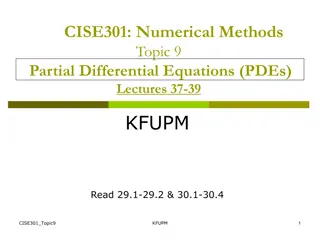Advancing Physics-Informed Machine Learning for PDE Solving
Explore the need for numerical methods in solving partial differential equations (PDEs), traditional techniques, neural networks' functioning, and the comparison between standard neural networks and physics-informed neural networks (PINN). Learn about the advantages, disadvantages of PINN, and ongoi
3 views • 14 slides
Enhancing Finite Element Analysis with Overlapping Finite Elements in Julia
Finite Element Methods (FEM) play a crucial role in solving complex PDEs in various domains. Overlapping Finite Elements in Julia aim to minimize reliance on mesh quality, improving solution accuracy. By leveraging Julia's matrix capabilities and efficient implementations, users can achieve faster c
1 views • 19 slides
Professor Willi Jäger - Mathematics in Understanding and Controlling COVID-19
Professor Willi Jäger from the University of Heidelberg, Germany, is a renowned mathematician with a special focus on nonlinear systems, PDEs, and mathematical modeling. He has received numerous prestigious scientific awards and has made significant contributions to various fields of interest. Join
4 views • 5 slides
Partial Differential Equations (PDEs) in Numerical Methods
Explore the world of Partial Differential Equations (PDEs) in the context of numerical methods. Learn about PDE classification, linear and nonlinear PDEs, notation, representing solutions, and applications like the heat equation. Dive into examples and concepts to enhance your understanding.
4 views • 69 slides
Overview of Numerical Methods in Computational Fluid Dynamics
This material delves into the properties, discretization methods, application in PDEs, grid considerations, linear equations solution, and more involved in Numerical Methods in Computational Fluid Dynamics. It covers approaches to fluid dynamical problems, components of numerical methods, and their
4 views • 40 slides
Non-uniformly Communicating Data: A PETSc Case Study
Developing parallel applications involves discretizing physical equations, representing domains as data points, and abstracting details using numerical libraries like PETSc. PETSc provides tools for solving PDEs, creating vectors and matrices, and utilizing parallel data layout for efficient process
2 views • 30 slides
Solving High-Dimensional PDEs Using Deep Learning for Finance and Beyond
Learn how neural networks are revolutionizing the solution of high-dimensional partial differential equations in finance and other fields, overcoming the Curse of Dimensionality. Discover the power of deep learning in modeling complex dynamic systems and the impact on numerical algorithms for PDE-ba
1 views • 22 slides
Dynamical Modeling Approaches for Control Analysis and Simulation
Explore different modeling and simulation techniques such as ODEs, PDEs, state machines, and hybrid approaches in control engineering. Understand the importance of models, uncertainty in simulations, and the role of physics-based and input-output models in control systems. Dive into the world of dyn
5 views • 23 slides
Mathematical Foundations of Data Science and Computational Sciences
Explore the critical role of mathematics in data science, computational sciences, and domain-specific applications. Discover the mathematical infrastructure supporting data science goals, including self-organization, clustering, and knowledge modeling. Delve into core mathematical activities such as
3 views • 18 slides
CAD/CAM Data Exchange Formats: Evolution and Importance
Explore the evolution of CAD/CAM data exchange formats, from graphics and data standards to the transfer of modeling data like shape, non-shape, design, and manufacturing information. Learn about common data exchange formats like IGES and PDES, essential for integrating and automating the design and
3 views • 9 slides
Integration of Ordinary Differential Equations and Chaos in Dynamics
Explore the integration of ordinary differential equations in chemical reactions, fluid mechanics, and quantum mechanics, including examples of ODEs and PDEs. Understand how higher-order ODEs reduce to first-order, initial value problems, autonomous systems, fixed points, and chaos in dynamics. Delv
17 views • 23 slides
Computational Methods in Engineering: Introduction to Partial Differential Equations
Explore the basics of Parabolic Partial Differential Equations (PDE) and their semi-discretization techniques in computational engineering. Learn about common Finite Difference methods for solving various types of PDEs. Dive into the world of PDEs with a focus on diffusion, advection-diffusion, Lapl
3 views • 21 slides
2025 Trends in AI, Hardware, and Modeling: PyTorch, Intel GPUs, and More
Discover the latest trends in AI, hardware, and modeling for 2025, including advancements in PyTorch, Intel GPUs, diffusion techniques, and AI benchmarks. Explore topics like memory in time-dependent PDEs, inverse bench framework, and new models such as Xiaomi MiMo-7B. Stay informed about cutting-ed
4 views • 14 slides












